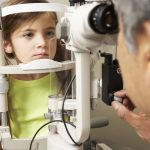Are Your Kids at Risk of Myopia?
Written by Dr. David Evans Last modified on April 24, 2019
Myopia (nearsightedness) is a very common vision problem in which near vision is clear, while distance vision is blurry. It is often caused during childhood if the eyeball is too long or if the curvature of the cornea is too great.
Although myopia is an easily treated refractive error (contact lenses, glasses or refractive surgery can correct the issue), it’s quite alarming to see incidences of myopia on the rise. Over the last 40 years, the prevalence of myopia in the U.S. has increased by nearly 20 percent. The growing rates of myopia is not simply an American issue either, it’s a worldwide concern, with certain parts of Asia seeing the worst of it. In fact, studies have suggested that as much as 80 percent of the Asian population has myopia, which is simply staggering. (In Seoul, South Korea, more than 96 percent of 19-year old males are nearsighted!)
There are a number of causative factors believed to be related to the surge in nearsightedness (such as genetics), but I wanted to focus on one that I find particularly interesting: the theory that too much time spent indoors increases risk factors for myopia in children.
The initial thinking that links time spent indoors with myopia focused on what children were typically doing when indoors. Taking this sort of indoor activity as a risk factor for myopia into consideration, it begins to make sense why the prevalence of myopia in Asian countries is so much higher. For example, a report from the Organisation for Economic Co-operation and Development found that 15-year old children in Shanghai, China spent nearly 14 hours per week on studies and homework. This is nearly triple the time spent by children of the same age in the U.S. and U.K. So it seems plausible that close-focus work could potentially be altering the growth of eyeballs in children.
 This is where things get more interesting. There have been several studies of children weighing the effects of indoor activity versus outdoor activity in the development of myopia. These studies confirmed that children who spent more time outside were less likely to develop myopia than those who spent more time inside. You might think it’s as simple as being outdoors as opposed to sitting inside partaking in some of the close-focus activities described above. But that’s not really the case. The studies didn’t stop children from reading outdoors, or playing with tablets or smartphones. Instead, it was the exposure to bright light that caught the attention of the researchers. This exposure is viewed by some as a protection against the development of myopia, but it’s hardly a concrete theory. Others believe that the greater viewing distances that children are exposed to outside absolutely plays some role.
This is where things get more interesting. There have been several studies of children weighing the effects of indoor activity versus outdoor activity in the development of myopia. These studies confirmed that children who spent more time outside were less likely to develop myopia than those who spent more time inside. You might think it’s as simple as being outdoors as opposed to sitting inside partaking in some of the close-focus activities described above. But that’s not really the case. The studies didn’t stop children from reading outdoors, or playing with tablets or smartphones. Instead, it was the exposure to bright light that caught the attention of the researchers. This exposure is viewed by some as a protection against the development of myopia, but it’s hardly a concrete theory. Others believe that the greater viewing distances that children are exposed to outside absolutely plays some role.
The long and short of it is that there is a definitive link between time spent indoors and increased risk of myopia in children. The exact nature of this correlation is not known, but it certainly plays into a larger issue that has gained attention in recent years: getting kids more active. These days there are so many distractions to keep kids leading sedentary, indoor lifestyles. Beyond risk factors for myopia, it’s leading to a host of other health issues such as obesity. If you’re an NFL fan, you’ve no doubt heard of their “Fuel Up to Play60” program designed to empower youths to stay active and healthy.
Read more about the correlation between indoor-outdoor activity and myopia, check out this article from Nature: http://www.nature.com/news/the-myopia-boom-1.17120




